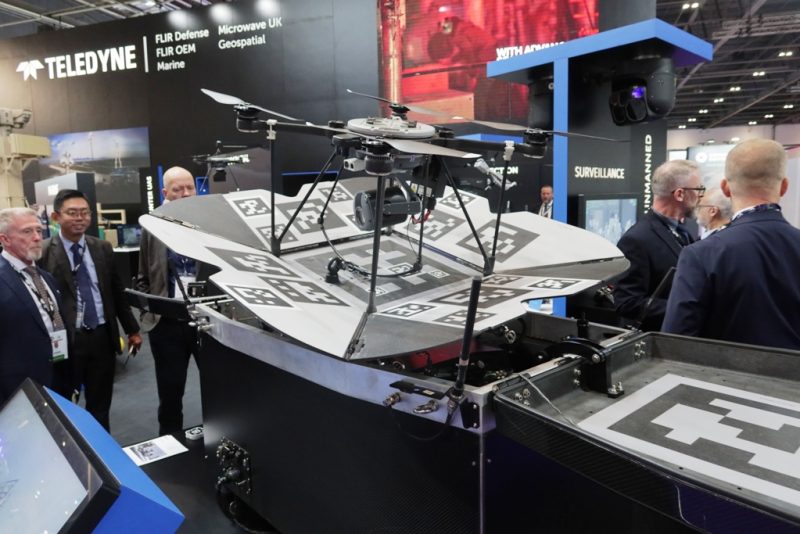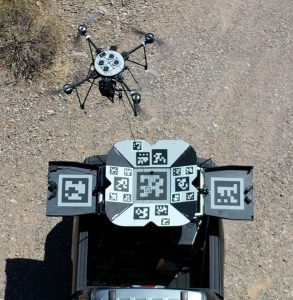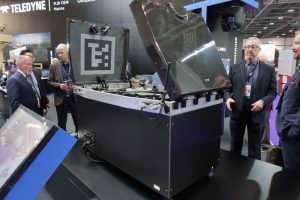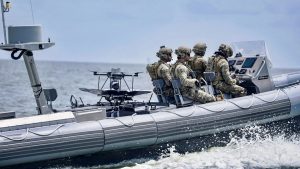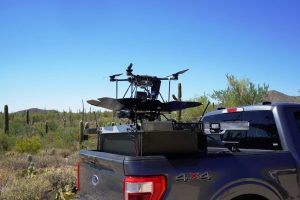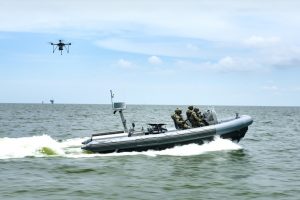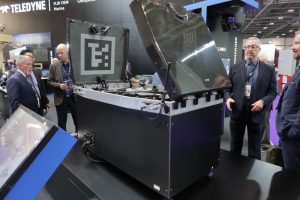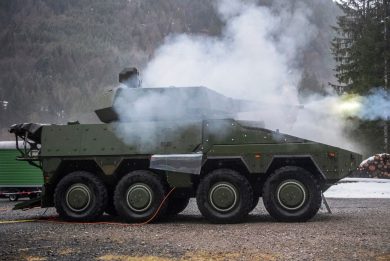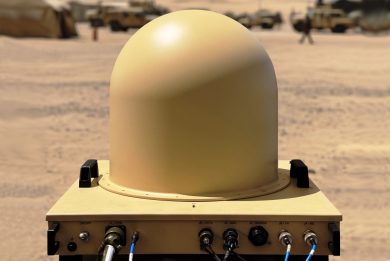DSEI 2025 – SkyCarrier™, an autonomous UAS launch and recovery platform by Teledyne FLIR Defense
At DSEI 2025 Teledyne FLIR Defense unveils its SkyCarrier, a platform designed to allow the company SkyRaider® and SkyRanger® to operate autonomously from a land or naval platform on the move.
Two years ago, at DSEI 2023, Teledyne FLIR unveiled its BlackRecon, a beefed-up version of the hand launched BlackHornet aimed at providing armoured vehicles an integral short range reconnaissance capability with recoverable UAS. EDR On-Line understands that the system is in the very final development phase and should be unveiled as a product in one of next year defence exhibitions. At DSEI 2025 the US company exhibits for the first time the SkyCarrier, a take-off and landing platform that allows small land vehicles and naval vessels to autonomously operate company quadcopters such as the SkyRanger R70 or the SkyRaider R80D. Two versions of the SkyCarrier are available, one for freeflight operations and one for tethered operations, the latter being slightly bigger and heavier as it hosts the reeling system and the cable.
The system comes as a box, dimensioned to host both quadcopters, protecting the drone from debris and weather; when a mission is called the two parts of the cover rotate and the landing pad is raised, its sides opening like petals, maintaining a slight angle compared to the central landing pad. All surfaces, including the inside of the covers, carry QR codes and AprilTags [1], the SkyCarrier being also fitted with near-infrared beacons; all those systems allow the drone to navigate back to the pad and land in full autonomy with utmost precision.
This high accuracy allows to reduce to a minimum the landing pad dimensions, increasing the SkyCarrier versatility as it can be installed even on small platforms. The new Teledyne FLIR Defense system features an active compensation system, located under the pad, which allows landing even when the vehicle has a 20° inclination. The system has been tested on board rigid hull inflatable boats as well as on light armoured land platforms demonstrating its reliability.
In the free flight configuration, the SkyCarrier box is 1.6 metres long, 0.75 metres wide and 0.8 metres high and has a mass of 120 kg. Take-off and landing operations can be performed at a maximum speed of 50 km/h, recharging time with XL batteries being less than 40 minutes. Input voltage can be 120 V/60 Hz or 230 V/50 Hz, and can be provided by a generator, an outside power source, or by an integrated power source. As both quadcopters have an endurance of over 45 minutes with those batteries, this allows to rotate them, maintaining a constant eye-in-the-sky for long periods. When recovered in the SkyCarrier the drone not only reloads batteries, but it can be shielded from high or low temperatures; while both quadcopters can operate up to 50°C and down to -20/-30°C, an active thermal management system allows to cope with extreme weather conditions. The SkyCarrier also acts as ground control station and is capable of a 50 Mbps input/output data rate via data link; it can control up to 16 different drones.
As for the tethered version, this has a 170 kg mass, due to the reeling system, and is wider, 1.2 metres, while length and height remain similar. Maximum take-off and landing speed is marginally reduced, 45 km/h. Here endurance is not an issue, as the quadcopter receives power from the tether, which is also used to download imaged and video feeds, as well as for command purposes, allowing RF-silent mode operations when needed. Both versions are IP 65 protected, can withstand shocks up to 40 g, can operate in the -20°C/+50°C temperature range, and complies with MIL810G/MIL810H standards.
As said, the SkyCarrier can host two different quadcopters developed by Teledyne FLIR Defense. The bigger one is the R70 SkyRanger, has a mass without payload of 5 kg, and can carry a payload up to 3.5 kg. It can fly at a speed of 65 km/h, with bursts up to 100 km/h, can sustain a 65 km/h wind with gusts up to 95 km/h, and has a maximum ceiling of 15,000 ft. The R80D SkyRaider has a mass without payload of 4.5 kg and carries a 2 kg payload. It can reach a speed of 50 km/h and can withstand a 65 km/h wind. Both quadcopters can be fitted with several different sensor suites, also developed and produced by Teledyne FLIR Defense, as well as by other payloads from third parties.
Teledyne FLIR Defense performed numerous internal trials and testing, both static and on the move.
The SkyCarrier was tested for fixed emplacement security, considering long term monitoring via a tethered UAS, as well as rapid response in the free flight system configuration. On the move tests were carried out both on ground vehicles and small vessels, in the US Gulf. It has been integrated onto various pickup trucks, such as Ford F150, F250, GMC Sierra, Toyota Hillux, etc., and on several naval vessels such as Zodiac Milpro 7 and 9 metres RHIBs and the CB90 fast attack craft.
The SkyCarrier has also been tested with many potential customers. These include US military, more specifically the Air Force, as well as the Norwegian MoD, which tested it both on land and sea. Coast Guard forces also tested the new Teledyne FLIR Defense product.
Currently the company is in active conversations with various government and commercial customers. While SkyRaider and SkyRanger UAS platforms and their family of payloads are already in service, hence at TRL9, the SkyCarrier itself is TRL6-7 with initial units expected to be delivered in Q2 2026.
Photos courtesy Teledyne FLIR Defense
[1] An AprilTag is a visual reference system or a visual target. AprilTags can be detected by sensors such as cameras or lasers.

